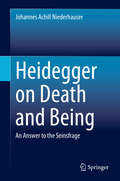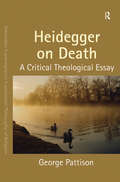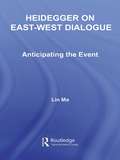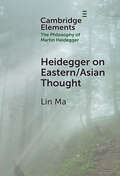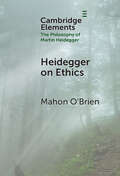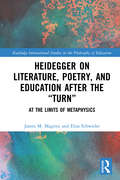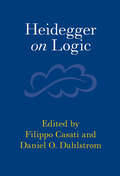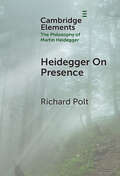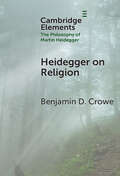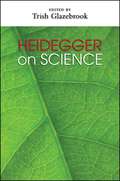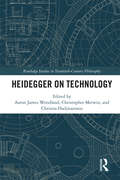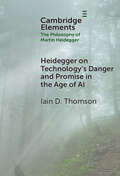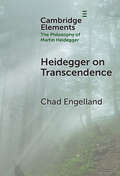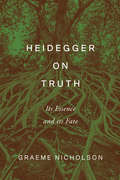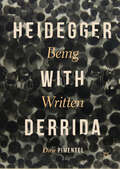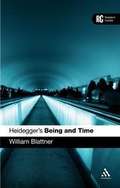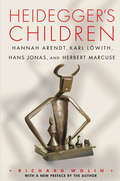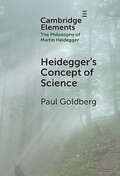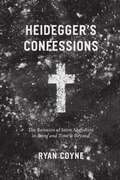- Table View
- List View
Heidegger on Concepts, Freedom and Normativity
by Sacha GolobThis book offers a fundamentally new account of the arguments and concepts which define Heidegger's early philosophy, and locates them in relation to both contemporary analytic philosophy and the history of philosophy. Drawing on recent work in the philosophy of mind and on Heidegger's lectures on Plato and Kant, Sacha Golob argues against existing treatments of Heidegger on intentionality and suggests that Heidegger endorses a unique position with respect to conceptual and representational content; he also examines the implications of this for Heidegger's views on truth, realism and 'being'. He goes on to explore Heidegger's work on the underlying issue of normativity, and focuses on his theory of freedom, arguing that it is freedom that links the existential concerns of Being and Time to concepts such as reason, perfection and obligation. His book offers a distinctive new perspective for students of Heidegger and the history of twentieth-century philosophy.
Heidegger on Death and Being: An Answer to the Seinsfrage
by Johannes Achill NiederhauserThe book is the first detailed and full exegesis of the role of death in Heidegger’s philosophy and provides a decisive answer to the question of being. It is well-known that Heidegger asked the “question of being”. It is equally commonplace to assume that Heidegger failed to provide a proper answer to the question. In this provocative new study Niederhauser argues that Heidegger gives a distinct response to the question of being and that the phenomenon of death is key to finding and understanding it. The book offers challenging interpretations of crucial moments of Heidegger’s philosophy such as aletheia, the history of being, time, technology, the fourfold, mortality, the meaning of existence, the event, and language. Niederhauser makes the case that any reading of Heidegger that ignores death cannot fully understand those concepts. The book argues that death is central to Heidegger’s “thinking path” from the early 1920s until his late post-war philosophy. The book thus attempts to show that there is a unity of the early and late Heidegger often ignored by other commentators. Niederhauser argues that death is the fulcrum of Heidegger’s ontology and the turning point of the history of being. Death resurfaces at the most crucial moments of the “thinking path” – from beginning to end.The book is of interest to those invested in current debates on the ethics of dying and the transhumanist project of digital human immortality. The text also shows that for Heidegger philosophy means first and foremost to learn how to die. This volume speaks to continental and analytical philosophers and students alike as it draws on a number of diverse Heidegger interpretations and appreciates intercultural differences in reading Heidegger.
Heidegger on Death: A Critical Theological Essay (Intensities: Contemporary Continental Philosophy of Religion)
by George PattisonThis book examines the question of death in the light of Heidegger's paradigmatic discussion in Being and Time. Although Heidegger's own treatment deliberately refrains from engaging theological perspectives, George Pattison suggests that these not only serve to bring out problematic elements in his own approach but also point to the larger human or anthropological issues in play. Pattison reveals where and how Heidegger and theology part ways but also how Heidegger can helpfully challenge theology to rethink one of its own fundamental questions: human beings' relation to their death and the meaning of death in their religious lives.
Heidegger on East-West Dialogue: Anticipating the Event
by Lin MaThis book traces a most obscure and yet most intriguing theme concealed in Heidegger’s thinking and work, which has hitherto not yet been made the focus of a thorough and sustained investigation: that is, the emergence and course of Heidegger’s interest in East Asian thought and of his reflection on East-West dialogue. Lin Ma covers such complex issues as Heidegger’s thoughts on language, Being, technology, the other beginning, and the journey abroad, with a view to their implications for East-West dialogue. It reveals the significance of his remarks on the early Greek’s confrontation with the Asiatic, and presents contextualized interpretations of his fleeting references to the topic of East-West dialogue and of his encounter with the Daodejing. Finally, it delves into "A dialogue on language" and exposes the strains and tensions that accompany Heidegger’s extension of dialogue and the Same, the two notions central to his thought, to the question of East-West dialogue. In the end, Lin Ma concludes that Heidegger’s fundamental concerns and philosophical orientations as articulated in terms of the history of Being and the other beginning have restricted him from engaging more seriously with the irresolvable and yet enduring issue of East-West dialogue.
Heidegger on Eastern/Asian Thought (Elements in the Philosophy of Martin Heidegger)
by Lin MaThis Element elucidates the metamorphoses of Heidegger's comportment toward Eastern/Asian thought from the 1910s to the 1960s. With a view to the many meanings of the East at play in Heidegger's thinking, it considers how his diversified 'dialogues' with the East are embedded in different phases of his Denkweg. Various themes unexplored previously are examined: Heidegger's early treatment of near Eastern traditions and Islamic philosophy, his views on alien cultures, the 'primitive Dasein' and the 'mythical Dasein,' and his meditation on Russianism's deeply rooted spirituality and its recuperative possibilities for the West. Finally, this Element reveals how Heidegger opened the promise of a dialogue with the East and yet stepped back from the threshold, and how his move from the Occidental line of philosophizing toward the Oriental line is integral to his shift from the guiding question of “Being” to the abyssal question of 'Beyng.'
Heidegger on Ethics (Elements in the Philosophy of Martin Heidegger)
by Mahon O'BrienHeidegger is often understood to have forsaken the very possibility of ethics – we find numerous variations of this view in the secondary literature. And yet, in Letter on Humanism, Heidegger stresses the importance of ethics (thought anew as originary ethics) in the context of the dangers posed by the technological age. In this Element, the author will try to unpack what Heidegger might have meant by this. Ultimately, his account of the essence of the human being will prove to be the key to understanding what he describes as 'originary ethics'.
Heidegger on Literature, Poetry, and Education after the “Turn”: At the Limits of Metaphysics (Routledge International Studies in the Philosophy of Education #45)
by James M. Magrini Elias SchwielerOffering new and original readings of literature, poetry, and education as interpreted through the conceptual lens of Heidegger’s later philosophy of the "Turn", this book helps readers understand Heidegger’s later thought and presents new takes on how to engage the themes that emerged from his later writing. Suggesting novel ways to consider Heidegger’s ideas on literature, poetry, and education, Magrini and Schwieler provide a deep understanding of the "Turn," a topic not often explored in contemporary Heideggerian scholarship. Their inter- and extra-disciplinary postmodern approaches offer a nuanced examination, taking into account Heidegger’s controversial place in history, and filling a gap in educational research.
Heidegger on Logic
by Daniel O. Dahlstrom Filippo CasatiDoes adherence to the principles of logic commit us to a particular way of viewing the world? Or are there ways of being – ways of behaving in the world, including ways of thinking, feeling, and speaking – that ground the normative constraints that logic imposes? Does the fact that assertions, the traditional elements of logic, are typically made about beings present a problem for metaphysical (or post-metaphysical) prospects of making assertions meaningfully about being? Does thinking about being (as opposed to beings) accordingly require revising or restricting logic's reach – and, if so, how is this possible? Or is there something precious about the very idea of thinking the limits of thinking? Contemporary scholars have become increasing sensitive to how Heidegger, much like Wittgenstein, instructively poses such questions. Heidegger on Logic is a collection of new essays by leading scholars who critically ponder the efficacy of his responses to them.
Heidegger on Poetic Thinking (Elements in the Philosophy of Martin Heidegger)
by Charles BambachOne of the striking features of Heidegger's philosophical engagement concerns his privileging of poetry and poetic thinking. In this understanding of language as fundamentally poetic, Heidegger puts forward a different way to do philosophy. In this Element, the author places Heidegger's poetic thinking in conversation with Sophocles and Hölderlin as a way to situate his critique of global technology and instrumental thinking in the postwar years. This Element also offers a critique of Heidegger's efforts to arrogate poetic thinking to his own aim of a destinal form of German national self-assertion through poetry. Overall, the aim here is to show how crucial poetic thinking is to the way Heidegger understands philosophy as a radical engagement with language.
Heidegger on Presence (Elements in the Philosophy of Martin Heidegger)
by Richard PoltHeidegger calls the thought that 'being is presence' the 'thunderbolt' that led him to link being and time and inspired his deconstruction of Western metaphysics. However, the scope of the concept of presence varies in his texts; the narrower it is, the more dramatic yet less plausible is his 'thunderbolt.' What is presence? Does Heidegger ultimately reject presence as the meaning of being, or does he accept it if conceived broadly enough? This study surveys the meaning and status of 'presence' in Heidegger. The author argues that he maintains a critical perspective, and that his critique can be applied not only to the tradition as interpreted in his 'history of being,' but also to contemporary phenomena such as information technology.
Heidegger on Religion (Elements in the Philosophy of Martin Heidegger)
by Benjamin D. CroweThroughout his career, Heidegger explored the religious sides of life in ways that had far-reaching impacts on the thought of his contemporaries and successors. This Element examines three important stops along Heidegger's ways of thinking about religion as the risky performance of life in new spaces of possibility. Section 1 examines Heidegger's 1920–1921 lectures on Paul, while Section 2 turns to the darker period of the late 1930s, exploring how Heidegger reconfigures religion in the context of his “new inception” of thought beyond metaphysics. Finally, Section 3 takes up Heidegger's challenging discussions of the divine in several postwar addresses and essays. In each case, Heidegger argues that we must suspend, bracket, or rescind from our tendencies to order, classify, define, and explain things in order to carry out a venture into a situation of indeterminacy and thereby recast religion in a new light.
Heidegger on Science
by Trish GlazebrookAlthough Martin Heidegger is well known for his work on technology, he is not often discussed in the context of science broadly speaking. This volume is the first to showcase diverse perspectives on Heidegger's assessments of the sciences, looking at a number of different ways that Heidegger's writings contribute to questions concerning how we understand the world through science. With particular attention to quantum theory, natural science, technoscience, and a section devoted specifically to investigating what Being and Time has to say about science, the book will be of interest to scholars in a wide range of disciplines and traditions. It closes with consideration of questions about sustainability and ethics raised by Heidegger's engagement with the sciences.
Heidegger on Technology (Routledge Studies in Twentieth-Century Philosophy)
by Christos Hadjioannou Aaron James Wendland Christopher MerwinThis collection offers the first comprehensive and definitive account of Martin Heidegger’s philosophy of technology. It does so through a detailed analysis of canonical texts and recently published primary sources on two crucial concepts in Heidegger’s later thought: Gelassenheit and Gestell. Gelassenheit, translated as ‘releasement’, and Gestell, often translated as ‘enframing’, stand as opposing ideas in Heidegger’s work whereby the meditative thinking of Gelassenheit counters the dangers of our technological framing of the world in Gestell. After opening with a scholarly overview of Heidegger’s philosophy of technology as a whole, this volume focuses on important Heideggerian critiques of science, technology, and modern industrialized society as well as Heidegger’s belief that transformations in our thought processes enable us to resist the restrictive domain of modern techno-scientific practice. Key themes discussed in this collection include: the history, development, and defining features of modern technology; the relationship between scientific theories and their technological instantiations; the nature of human agency and the essence of education in the age of technology; and the ethical, political, and environmental impact of our current techno-scientific customs. This volume also addresses the connection between Heidegger’s critique of technology and his involvement with the Nazis. Finally, and with contributions from a number of renowned Heidegger scholars, the original essays in this collection will be of great interest to students of Philosophy, Technology Studies, the History of Science, Critical Theory, Environmental Studies, Education, Sociology, and Political Theory.
Heidegger on Technology's Danger and Promise in the Age of AI (Elements in the Philosophy of Martin Heidegger)
by Iain D. ThomsonHow exactly is technology transforming us and our worlds, and what (if anything) can and should we do about it? Heidegger already felt this philosophical question concerning technology pressing in on him in 1951, and his thought-full and deliberately provocative response is still worth pondering today. What light does his thinking cast not just on the nuclear technology of the atomic age but also on more contemporary technologies such as genome engineering, synthetic biology, and the latest advances in information technology, so-called “generative AIs” like ChatGPT? These are some of the questions this book addresses, situating the latest controversial technologies in the light of Heidegger's influential understanding of technology as an historical mode of ontological disclosure. In this way, we seek to take the measure of Heidegger's ontological understanding of technology as a constellation of intelligibility with an important philosophical heritage and a dangerous but still promising future.
Heidegger on Thinking (Elements in the Philosophy of Martin Heidegger)
by Lee BraverEvery philosophy is a celebration of the fact that being can be thought, that the world around us yields to concepts that join together into arguments which can lead us to new thoughts and new ways of thinking. Heidegger's great talent was to never lose his philosophical wonder at philosophy, to never stop thinking about thinking. Heidegger's early work favors a somewhat pragmatic view of thinking as organized by and around our projects, emphasizing tacit skills over articulate conscious thinking. It also explores stepping back from all projects in dread and wonder. His later thinking is reciprocal rather than autonomous, something we do with and for being instead of something we do to or on beings, which can help overcome contemporary nihilism. After the death of God, we may no longer be able to pray to a divinity, but we can still be the thinkers of being.
Heidegger on Transcendence (Elements in the Philosophy of Martin Heidegger)
by Chad EngellandElements in the Philosophy of Martin Heidegger
Heidegger on Truth: Its Essence and its Fate (New Studies in Phenomenology and Hermeneutics)
by Graeme Nicholson"What is truth?" This famous question received a novel answer from Martin Heidegger, based on the methods of phenomenology. The 1930 address "On the Essence of Truth" takes us on a pathway of thinking that starts from the standard "correspondence theory of truth," and moves into larger discussions on truth, including the freedom of human conduct and choices. Heidegger on Truth is a close reading of a significant article by Heidegger entitled "On the Essence of Truth." The first part is a reading of the 1930 lecture which forms the basis of the article eventually published in 1943 and again, in revised form, in 1949. It is followed by a second part in which Nicolson compares the lecture with its subsequent versions eliciting the subsequent changes and detours of his thoughts on 'truth' over this period. The second part of the book also includes chapters on his interpretation of Plato, scholasticism and the tradition of modern rationalism. Accessibly written, this book is a very thorough examination of Heidegger's thoughts on the concept of "truth."
Heidegger with Derrida: Being Written
by Dror PimentelHeidegger with Derrida: Being Written attempts, for the first time, to think Heidegger's philosophy through the lens of Derrida's logocentric thesis, according to which speech has, throughout the history of metaphysics, been given primacy over writing. The book offers a detailed account of Derrida's arguments about the debasement of writing, an account that leads to a new definition of writing, conceiving it epistemically, rather than linguistically. Heidegger's analysis of the gaze and critique of the modern subject are shown to have logocentric features. This surprising conclusion entails that Heidegger is well within the metaphysical tradition, which he labored so intently to overcome. The book sheds new light on the philosophical roots of Heidegger’s involvement with Nazism, arguing that his hierarchical thinking--the hallmark of logocentrism and metaphysics—condones violent differentiation between the ‘proper’ race and the Other.
Heidegger's Being and Time (Reader's Guides)
by William Blattner<p>Continuum's Reader's Guides are clear, concise and accessible introductions to classic works of philosophy. Each book explores the major themes, historical and philosophical context and key passages of a major philosophical text, guiding the reader toward a thorough understanding of often demanding material. Ideal for undergraduate students, the guides provide an essential resource for anyone who needs to get to grips with a philosophical text. <p><i>Heidegger's Being and Time</i> is one of the most influential and controversial philosophical treatises of the 20th century. It had a profound impact on Sartre and Merleau-Ponty in their further development of phenomenology and existentialism, hugely influenced Gadamer's hermeneutics, and paved the way, partly directly and partly indirectly through Heidegger's later thought, for the emergence of deconstructionism. In addition to being a very important text, it is also a very difficult one. Heidegger presents a number of challenges to the the reader, asking them to abandon many assumptions fundamental to traditional philosophy, such as the mind/body distinction and the concept of substance. The text also introduces a whole host of new concepts and terms and as such is a hugely challenging, yet fascinating, piece of philosophical writing. <p>In <i>Heidegger's Being and Time: A Reader's Guide</i>, William Blattner explains the philosophical background against which the book was written and provides a clear and concise overview of the key themes and motifs. The book then examines this challenging text in details, guiding the reader to a clear understanding of Heidegger's work as a whole. Finally Blattner explores the reception and influence of the work and offers the student guidance on further reading. This is the ideal companion to study of this most influential and challenging of texts.
Heidegger's Being and Time: A Critical Guide (Cambridge Critical Guides)
by Aaron James Wendland Tobias KeilingMartin Heidegger's Being and Time, published in 1927, is widely regarded as his most important work and it has had a profound influence on twentieth-century philosophy. This Critical Guide draws on recently translated and published primary sources as well as the latest developments in Heidegger scholarship to provide a series of in-depth studies of this influential text. Twelve newly-written essays examine the unity of Being and Time; the nature of human communication; truth as a catalyst of cultural transformation; feminist approaches to Being and Time; the essence of authenticity; curiosity as an epistemic vice; the nature of rationality; realism and idealism; the ontological difference; the origin of time; the possibility of death; and the failure of the Being and Time project. The volume will be particularly valuable to students and scholars interested in phenomenology, existentialism, hermeneutics, metaphysics, epistemology, feminism, and ethics.
Heidegger's Black Notebooks: Responses to Anti-Semitism
by Peter Trawny Edited by Andrew J. MitchellFrom the 1930s through the 1970s, the philosopher Martin Heidegger kept a running series of private writings, the so-called Black Notebooks. The recent publication of the Black Notebooks volumes from the war years have sparked international controversy. While Heidegger’s engagement with National Socialism was well known, the Black Notebooks showed for the first time that this anti-Semitism was not merely a personal resentment. They contain not just anti-Semitic remarks, they show Heidegger incorporating basic tropes of anti-Semitism into his philosophical thinking. In them, Heidegger tried to assign a philosophical significance to anti-Semitism, with “the Jew” or “world Judaism” cast as antagonist in his project.How, then, are we to engage with a philosophy that, no matter how significant, seems contaminated by anti-Semitism? This book brings together an international group of scholars from a variety of disciplines to discuss the ramifications of the Black Notebooks for philosophy and the humanities at large. Bettina Bergo, Robert Bernasconi, Martin Gessmann, Sander Gilman, Peter E. Gordon, Hans Ulrich Gumbrecht, Michael Marder, Eduardo Mendieta, Richard Polt, Tom Rockmore, Peter Trawny, and Slavoj Žižek discuss issues including anti-Semitism in the Black Notebooks and Heidegger’s thought more broadly, such as German conceptions of Jews and Judaism, Heidegger’s notions of metaphysics, and anti-Semitism’s entanglement with Heidegger’s views on modernity and technology, grappling with material as provocative as it is deplorable. In contrast to both those who seek to exonerate Heidegger and those who simply condemn him, and rather than an all-or-nothing view of Heidegger’s anti-Semitism, they urge careful reading and rereading of his work to turn Heideggerian thought against itself. These measured and thoughtful responses to one of the major scandals in the history of philosophy unflinchingly take up the tangled and contested legacy of Heideggerian thought.
Heidegger's Children
by Richard WolinMartin Heidegger is perhaps the twentieth century's greatest philosopher, and his work stimulated much that is original and compelling in modern thought. A seductive classroom presence, he attracted Germany's brightest young intellects during the 1920s. Many were Jews, who ultimately would have to reconcile their philosophical and, often, personal commitments to Heidegger with his nefarious political views. In 1933, Heidegger cast his lot with National Socialism. He squelched the careers of Jewish students and denounced fellow professors whom he considered insufficiently radical. For years, he signed letters and opened lectures with ''Heil Hitler!'' He paid dues to the Nazi party until the bitter end. Equally problematic for his former students were his sordid efforts to make existential thought serviceable to Nazi ends and his failure to ever renounce these actions. This book explores how four of Heidegger's most influential Jewish students came to grips with his Nazi association and how it affected their thinking. Hannah Arendt, who was Heidegger's lover as well as his student, went on to become one of the century's greatest political thinkers. Karl Löwith returned to Germany in 1953 and quickly became one of its leading philosophers. Hans Jonas grew famous as Germany's premier philosopher of environmentalism. Herbert Marcuse gained celebrity as a Frankfurt School intellectual and mentor to the New Left. Why did these brilliant minds fail to see what was in Heidegger's heart and Germany's future? How would they, after the war, reappraise Germany's intellectual traditions? Could they salvage aspects of Heidegger's thought? Would their philosophy reflect or completely reject their early studies? Could these Heideggerians forgive, or even try to understand, the betrayal of the man they so admired? Heidegger's Children locates these paradoxes in the wider cruel irony that European Jews experienced their greatest calamity immediately following their fullest assimilation. And it finds in their responses answers to questions about the nature of existential disillusionment and the juncture between politics and ideas.
Heidegger's Concept of Science (Elements in the Philosophy of Martin Heidegger)
by Paul GoldbergThis Element argues that Heidegger's concept of science has two core features. Heidegger critiques a security-oriented concept of science, which he associates with the dominance of physics in modern science and metaphysics and with a progressive resistance among philosophers and scientists to ontological questioning. Meanwhile, Heidegger advances an access-oriented concept of science, on which science is essentially founded on ontological disclosures but also constantly open to the possibility of new revolutionary disclosures. This Element discusses how these commitments develop in Heidegger's early and later thinking, and argues that they inform his views on the history of Western metaphysics and on the possibilities for human flourishing that modernity, and modern science specifically, affords. The Element also discusses Heidegger's dialogue with Werner Heisenberg about quantum physics; and throughout, it highlights points of contact and divergence between Heidegger and other philosophers of science such as Karl Popper, Thomas Kuhn, Paul Feyerabend, and Helen Longino.
Heidegger's Confessions: The Remains of Saint Augustine in "Being and Time" and Beyond (Religion And Postmodernism Ser.)
by Ryan CoyneAlthough Martin Heidegger is nearly as notorious as Friedrich Nietzsche for embracing the death of God, the philosopher himself acknowledged that Christianity accompanied him at every stage of his career. In Heidegger's Confessions, Ryan Coyne isolates a crucially important player in this story: Saint Augustine. Uncovering the significance of Saint Augustine in Heidegger’s philosophy, he details the complex and conflicted ways in which Heidegger paradoxically sought to define himself against the Christian tradition while at the same time making use of its resources. Coyne first examines the role of Augustine in Heidegger’s early period and the development of his magnum opus, Being and Time. He then goes on to show that Heidegger owed an abiding debt to Augustine even following his own rise as a secular philosopher, tracing his early encounters with theological texts through to his late thoughts and writings. Bringing a fresh and unexpected perspective to bear on Heidegger’s profoundly influential critique of modern metaphysics, Coyne traces a larger lineage between religious and theological discourse and continental philosophy.
Heidegger's Conversations: Toward a Poetic Pedagogy (SUNY series in Contemporary Continental Philosophy)
by Katherine DaviesReading Martin Heidegger's five conversational texts together for the first time, Heidegger's Conversations elaborates not only what Heidegger thought but how he did so by attending to the philosophical possibilities of the genre of these under-studied texts written between 1944 and 1954. Though he wrote little on the topic of teaching and learning explicitly, Katherine Davies shows Heidegger performed an implicit poetic pedagogy in his conversations that remains to be recognized. Heidegger launched an experimental attempt to enact a learning of non-representational, non-metaphysical thinking by cultivating a distinctly collaborative sensitivity to the call of the poetic. Davies illustrates how each conversation emphasizes a particular pedagogical element—non-oppositionality, making mistakes, thinking in community, poetic interpretation, and the dangers of such pedagogy—which together constitute the developmental arc of these texts. Whether Heidegger is revising or reinforcing his own earlier pedagogical practices, Davies argues that attending to the dramatic staging of the conversations offers a distinct vantage point from which to contend with Heidegger's philosophy and politics in the post-war period.

